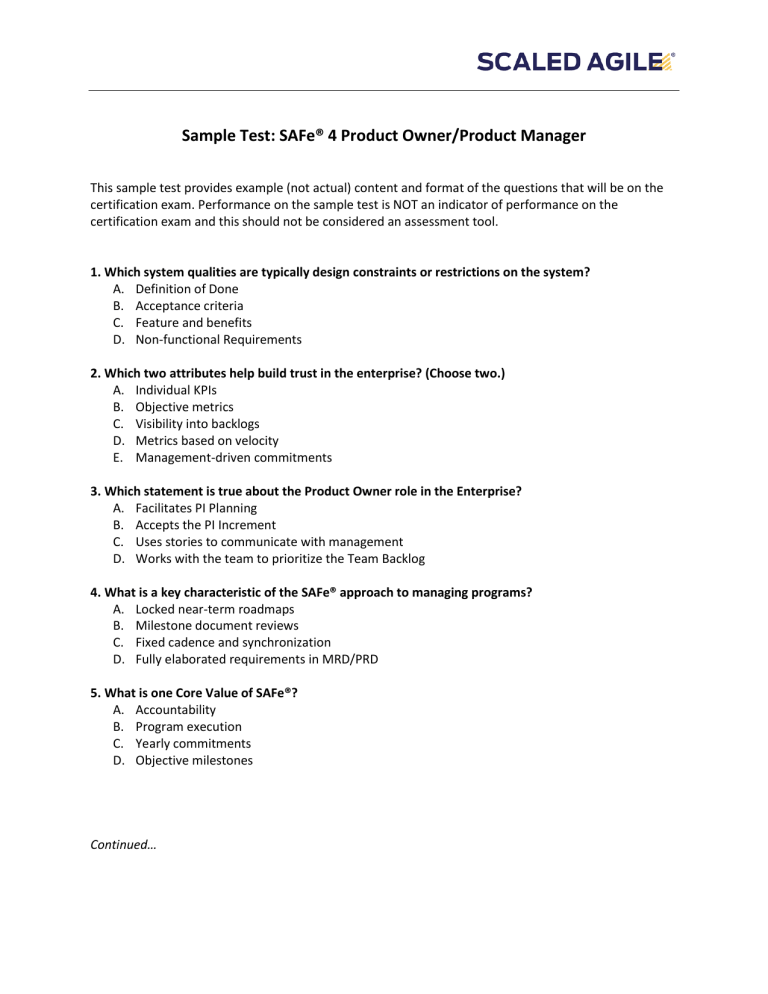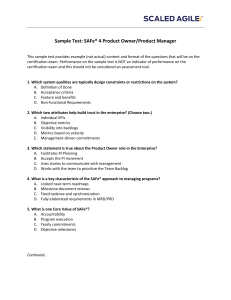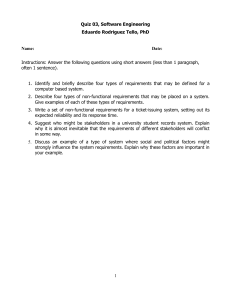
Sample Test: SAFe® 4 Product Owner/Product Manager This sample test provides example (not actual) content and format of the questions that will be on the certification exam. Performance on the sample test is NOT an indicator of performance on the certification exam and this should not be considered an assessment tool. 1. Which system qualities are typically design constraints or restrictions on the system? A. Definition of Done B. Acceptance criteria C. Feature and benefits D. Non-functional Requirements 2. Which two attributes help build trust in the enterprise? (Choose two.) A. Individual KPIs B. Objective metrics C. Visibility into backlogs D. Metrics based on velocity E. Management-driven commitments 3. Which statement is true about the Product Owner role in the Enterprise? A. Facilitates PI Planning B. Accepts the PI Increment C. Uses stories to communicate with management D. Works with the team to prioritize the Team Backlog 4. What is a key characteristic of the SAFe® approach to managing programs? A. Locked near-term roadmaps B. Milestone document reviews C. Fixed cadence and synchronization D. Fully elaborated requirements in MRD/PRD 5. What is one Core Value of SAFe®? A. Accountability B. Program execution C. Yearly commitments D. Objective milestones Continued… 6. How are PI objectives quantified? A. By using velocity B. By calculating ROI C. By totaling the Epic Budget D. By assigning Business Value 7. What is the Product Manager's role in PI Planning? A. Negotiate scope B. Provide traceability C. Define Solution Intent D. Decompose Capabilities into Stories 8. Who is responsible for accepting stories in the Iteration? A. Product Owner B. Product Manager C. Portfolio Manager D. System Architect 9. How is value at the Portfolio Level described? A. Capabilities and Features B. Features and User Stories C. Business and Enabler Epics D. Vision and Roadmap 10. Non-functional requirements are key architecture concerns and system qualities that are sometimes known as what? A. The “ilities”— reliability, usability, scalability, maintainability, etc. B. The purpose of strategy and investment funding C. The reporting structure that Lean Portfolio Management adheres to D. The portfolio context that includes quantitative measures 11. A Product Manager discusses a Feature with a client. This action is an example of what? A. Individuals and interactions B. Customer collaboration C. Change control measures D. Responding to change 12. What are two things a well thought out Vision communicates? (Choose two.) A. What are the non-functional requirements B. What problems are being solved C. How a Feature provides a Solution D. When a PI should be completed E. When teams should complete Features Continued… 13. What are the three components to Cost of Delay? (Choose three.) A. User-business value B. Time criticality C. Risk reduction - opportunity enablement D. Return on investment E. Marketability F. Job size 14. The Daily Stand-up time box recommendation is how many minutes? A. 15 minutes B. 5 minutes C. 20 minutes D. 30 minutes 15. The responsibility of representing the customer to the Agile team belongs to which role? A. Product Manager B. Solution Architect C. Product Owner D. Business Owner Answer Key: 1. D 2. BC 3. D 4. C 5. B 6. D 7. A 8. A 9. C 10. A 11. B 12. AB 13. ABC 14. A 15. C (End of sample test)



